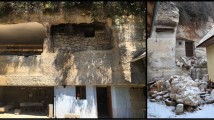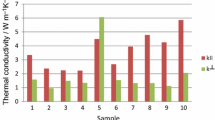Water is one of the causes of softening of soft rocks in deep strata. Water absorption in soft rock with high clay content may cause strength softening and deformation. In this paper, soft rock samples from three deep strata are investigated, and the stratigraphic characteristics such as stratum physical parameters, mineral composition, and pore structure are systematically analyzed. The characteristics of water vapor adsorption curves of deep strata soft rock are obtained by water vapor adsorption experiments. The authors analyzed the main factors controlling water vapor adsorption capacity of the rock samples. The experimental results show that the water vapor adsorption capacity increases with increase in humidity. When the humidity exceeds 0.8, the adsorption of water vapor by soft rock increases rapidly. The adsorption capacity of shale is significantly higher than that of conglomerate samples, and the difference between coarse conglomerate and fine conglomerate samples is insignificant. It is shown that water vapor adsorption correlates positively with clay mineral content, particularly minerals with high specific surface area. Under low humidity the temperature has little effect on the adsorption of soft rock water vapor. As the humidity increases, a rise in temperature can significantly increase the water vapor adsorption capacity The results also show that the soft rock water vapor adsorption capacity correlates negatively with initial moisture content, porosity, and permeability. This study is of great significance for understanding the hydrological characteristics and catastrophic processes of deep strata soft rocks.









Similar content being viewed by others
References
M. He, “Research progress and challenges of deep soft rock engineering,” J. China Coal Soc., 39(08), 1409-1417 (2014)
X. Sun and M. He, “Numerical simulation of coupled support of soft rock roadway in deep mining,” J. China Univ. Min. Technol., 02, 37-40 (2005).
M. He, H. Xie, S. Peng, and Y. Jiang, “Study on rock mechanics of deep mining,” Chin. J. Rock Mech. Eng., 16, 2803-2813 (2005).
L. Tang and S. Wang, “Research progress on the mechanical effects of water-rock chemical action on rock mass deformation and failure,” Adv. Earth Sci., 5, 433-439 (1999).
M. He, L. Zhou, D. Li, C. Wang, and W. Nie, “Experimental study on water absorption characteristics of deep well mudstone,” Chin. J. Rock Mech. Eng., 06, 1113-1120 (2008).
H. Kang, “Water damage to rocks,” Hydrogeol. Eng. Geol., 03, 39-41 (1994)
L. Zhou, M. He, J. Li, and G. Wang, “Experimental study on water absorption characteristics of sandstone,” J. PLA Univ. Sci. Technol. (Nat. Sci. Ed.), 10(06), 580-585 (2009).
C. Zhou, Y. Deng, et al., “Experimental study and application of softening of mechanical properties of saturated soft rock,” Chin. J. Rock Mech. Eng., 01, 33-38 (2005).
Q. Sun, C. Jiang, S. Zhu, and J. Wang, “Study on water stability test and mechanical properties of saturated rock,” J. Min. Safety Eng., 28(02), 236-240 (2011).
M. Shao, L. Li, and Z. Li, “Elastic wave velocity and mechanical properties of Longyou Grottoes in different water-bearing conditions,” Chin. J. Rock Mech. Eng., 29(S2), 3514-3518 (2010).
L.J. Feucht and J.M. Logan, “Effects of chemically active solutions on shearing behavior of a sandstone,” Tectonophysics, 175, 159-176 (1990).
T. Heggheim, M.V. Madland, R. Risnes, et al., “A chemical induced enhanced weakening of chalk by seawater,” J. Pet Sci. Eng., 46(3), 171-184 (2004).
X.T. Feng, S.L. Chen, and S.J. Li, “Effect of water chemistry on micro-cracking and compressive strength of granite,” Int. J. Rock Mech. Min. Sci., 38(4), 557 - 568 (2001).
C. Tien, Adsorption Calculations and Modeling, Butterworth-Heinemann, Boston USA (1994).
I. Langmuir, “The evaporation, condensation and reflection of molecules and the mechanism of adsorption,” J. Franklin Inst., 183(1), 101-102 (1917).
K. S. W. Sing, “Reporting physisorption data for gas/solid systems with special reference to the determination of surface area and porosity,” Pure Appl. Chem., 54(11), 2201-2218 (1982).
X. Zhao and Y. Zhang. “Study on clay minerals in Jidong Oilfield,” Nat. Gas Geosci., 05, 26-34 (1993).
Acknowledgments
This work was supported by the National Key Research and Development Plan of China (Grant No. 2016YFC0600901), the National Natural Science Foundation of China (Grant No. 51874311), the Special Fund of Basic Research and Operating, China University of Mining & Technology, Beijing (Grant No. 2009QL03), and the Yueqi Outstanding Scholar Award Program, China University of Mining and Technology, Beijing.
Author information
Authors and Affiliations
Corresponding author
Additional information
Translated from Khimiya i Tekhnologiya Topliv i Masel, No. 3, pp. 72 —78, May — June, 2020
Rights and permissions
About this article
Cite this article
Yang, L., Shi, F., Zheng, X. et al. Water Vapor Adsorption and Main Controlling Factors of Deep Shale. Chem Technol Fuels Oils 56, 429–440 (2020). https://doi.org/10.1007/s10553-020-01154-2
Published:
Issue Date:
DOI: https://doi.org/10.1007/s10553-020-01154-2




